Insect interest sparks Welsh farmer’s diversification
In the current economic climate, more and more farmers are looking for clever diversification to help improve their bottom line.
While B&Bs and farm shops are the obvious choice for many, an unusual option may appeal to some – insect production for food.
Welsh farmer Sarah Beynon first encountered a dung beetle at an agricultural show in her native Pembrokeshire.
Black and bold, the audacious Scarabaeoidea glided on to the back of the pedigree Welsh Black cow she was leading about the show ring.
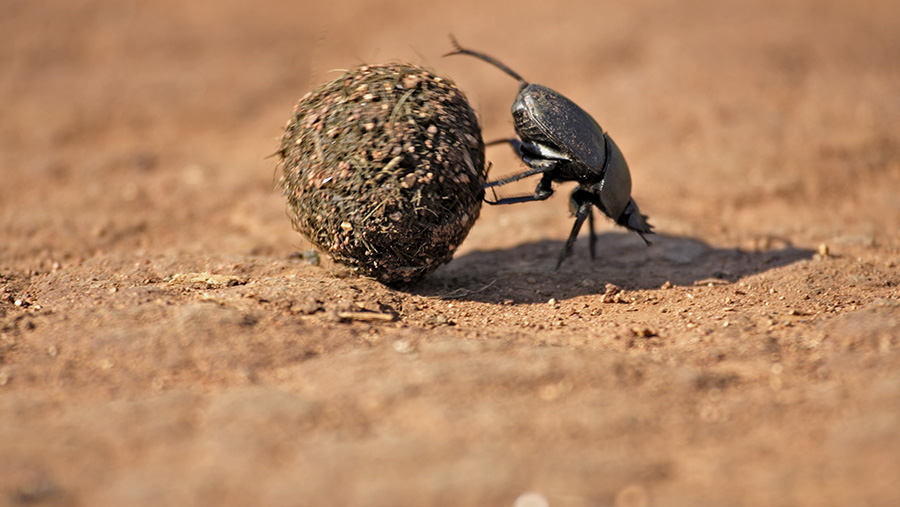
© jspix/imageBROKER-REX/Shutterstock
It was a brief but symbolic union and now, at 32, Sarah is a respected entomologist and a global expert on this industrious insect.
See also: Read more stories about farm diversifications
Her curiosity of creepy crawlies has its roots in her farm upbringing and the enlightening wildlife walks she enjoyed with her mother and grandmother.
Aside from her scientific research into the contribution the previously undervalued dung beetle can bring to UK agriculture, Sarah has established a business providing information to farmers about these soil-enriching insects.
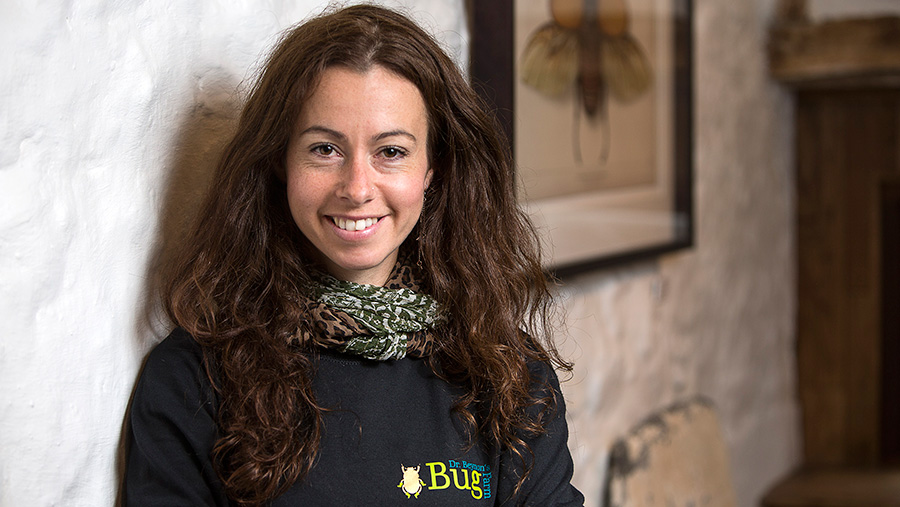
Sarah Beynon
And more recently she opened The Bug Farm near St Davids, on the farm once owned by her grandparents and then her late uncle.
It will channel her intense desire to showcase the wonders of the hidden and alien world of invertebrates and to demonstrate their importance in how food is produced.
Scientists, chefs and insect farmers are together looking at how insect production for human consumption, and for animal feed, can move forward as a growth industry here in the UK Sarah Beynon
Hands on with cockroaches
Sarah’s remarkable enthusiasm for bugs is infectious.
It took just seconds to convince the most squeamish of visitors to cradle one of the cockroaches inhabiting her bug zoo.
And not just any old cockroach, but the hissing kind.
She normalises the experience to such a level that it seems impolite not to get up close and personal to this much-maligned of creatures.
The insect community is indeed fortunate to have a champion in Sarah, even if she uses them as a food source for humans in her latest venture – the UK’s first insect restaurant.
Some research suggests that production of mealworms, crickets and other insects is more environmentally sound than producing other animal protein sources – hence why Sarah and her partner, chef Andy Holcroft, have opened Grub Kitchen.
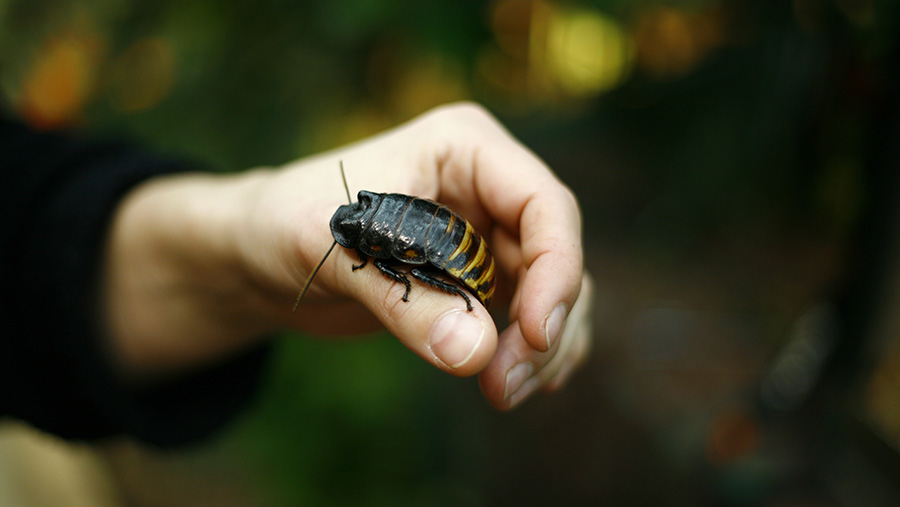
A hissing cockroach © Robin Hausmann/imageBROKER/REX/Shutterstock
For the time being, the insects must be sourced from overseas because there is no Food Standards Agency certification for producing human-grade insects in the UK, but that should be about to change.
“Scientists, chefs and insect farmers are together looking at how insect production for human consumption, and for animal feed, can move forward as a growth industry here in the UK,” Sarah says.
“We are expecting an announcement on this shortly.”
Until then, Andy must make do with insects bred in the Netherlands, Belgium, Spain and France to develop recipes to dish up at Grub Kitchen.
The restaurant is based in the former calf-rearing shed at Lower Harglodd Farm, St Davids. What might Sarah’s uncle have made of his niece’s plans for the farm?
“He would probably think I was bloody mad,” she laughs.
Insects v beef
In fact, she is anything but. Insect farming looks certain to be a growth industry as our precious resources diminish. Insects have a feed conversion efficiency that is between 12-25 times greater than cattle and their production requires very little land – in fact they can be bred in warehouses.
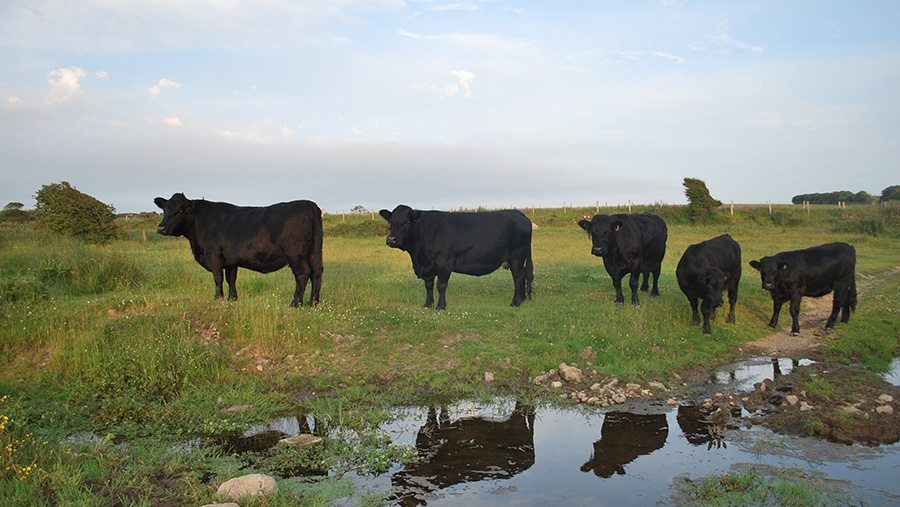
The Tyddewi herd
Sarah makes it clear that it’s not her mission to discourage people from eating meat per se – she is taking on her family’s herd of pedigree Welsh Black cattle, which she uses to conservation-graze the wildlife habitat at the farm.
But she thinks the planet would benefit if we all ate less meat and chose that meat more carefully.
It takes 2,250 litres of water to produce 150g of beef, but only one pint is needed to produce the same amount of insect protein.
“By 2050, the world will need to produce 70% more food and that will require 120% more water and yet the target is to reduce the impact that food production has on the environment by 50% of what it is today,” Sarah explains.
“Insects are part of the answer.
“It makes sense for the UK to move forward – to become a European, if not world, leader in the commercialisation of insect protein for human consumption and animal feed.”
Insects can be bred quickly and efficiently on a vegetarian diet.
“You have to factor the growing of these crops into their sustainability, but ideally in future, kitchen waste might be used as a food source,” says Sarah.
I began to realise how important insects were in agricultural systems and I could see that, by studying insects as indicators of the health of the environment, I could merge my loves of farming and insects Sarah Beynon
She doesn’t want to alienate meat producers; she sees parallels between conventional and insect producers.
“Dad nurtured my love of farming and taught me that every animal has a value.”
A love for insects
Sarah’s mother and grandmother were both teachers and this spilled over into her home life.
Any insect spotted on a wildlife walk would not just be noted – an entire project could emerge from a ladybird sighting.
“As a three-year-old, I had my own research projects,” Sarah recalls.
“I fell in love with the natural world and became particularly interested in what was happening beneath the soil surface.”
As a teenager, Sarah was settled on a science-based career, but had no idea what.
“I didn’t know if I wanted to be a vet or a scientist. I was quite certain that I wasn’t ready to farm at that point so I thought I’d study biology and see where that took me,” she says.
At Oxford University, Sarah’s interest in entomology grew when she met Darren Mann, the head of life collections at the university’s Natural History Museum.
“He opened up a whole cabinet of curiosities with the museum’s huge collection of pinned insects.
“I discovered a beautiful world of insects that many of us have no idea exists.
“I began to realise how important insects were in agricultural systems and I could see that, by studying insects as indicators of the health of the environment, I could merge my loves of farming and insects.”
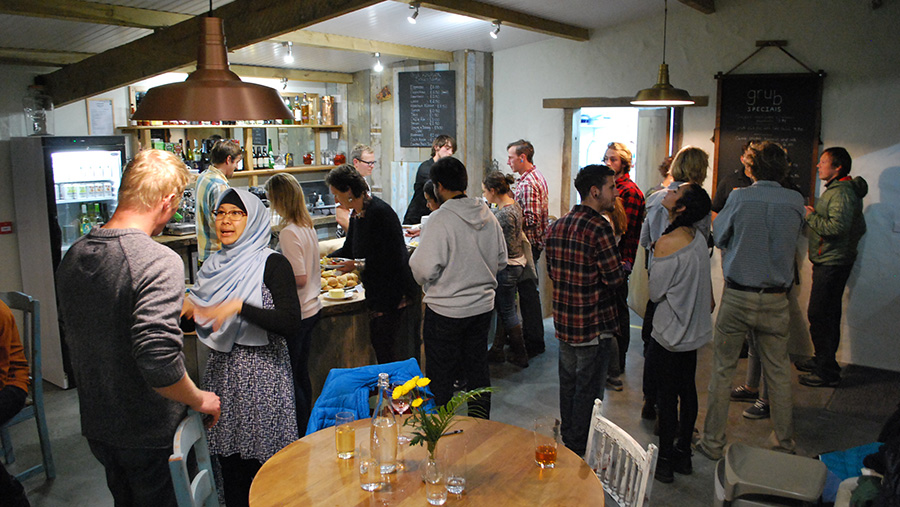
Diners in the Grub Kitchen
Finding and buying The Bug Farm
While Sarah was at university, her parents made a life-changing decision; they gave up the tenancy on the farm that her father’s family had farmed. The farm, in the shadow of St Davids Cathedral, was owned by the Church of Wales.
“The Church wanted to increase the rent and Dad was getting close to retirement so he decided that he would just keep 60 acres [24ha] of outlying land he owned.
“It wasn’t until that point that I understood just now much I loved farming. I felt that I was the reason why the family had to let the farm go and thought I would never again get the chance to farm.”
But that chance did present itself. In late 2013 Sarah had the opportunity to buy her uncle’s farm after he passed away.
Her PhD was almost complete and she had set herself a goal of owning a farm before she was 30.
With support from her parents, who sold land and invested money in land at the new farm, and her 99-year-old aunt, who was born at the farm, Sarah achieved her goal.
The land hadn’t been farmed for 15 years and was in a state of disrepair, but Sarah and Andy have rejuvenated it.
Creating The Bug Farm hasn’t been without its obstacles.
“If I had known how much money, time, stress and anxiety would be involved, I might not have been brave enough to take it on. I’m naturally not a risk taker and was brought up to believe that it was unwise to borrow money.”
That principle was almost confirmed when Sarah’s bank withdrew its support at the eleventh hour. Fortunately, another bank stepped in and she secured a loan.
Sarah also received support from the Pembrokeshire Coast National Park Sustainable Development Fund, the social entrepreneur charity, UnLtd, and the Welsh government’s tourism investment support scheme, as well as a further loan from Pembrokeshire Lottery.
After a “soft launch” last October, The Bug Farm is now open as a visitor attraction.
Aside from visitor attractions, which include a tropical bug zoo, bug art gallery and the Grub Kitchen – which is also open as a stand-alone restaurant – The Bug Farm is a centre for important research.
“Our key aim is to investigate the future of food production and showcase on the farm how efficient, science-led agriculture can work hand-in-hand with wildlife conservation,” Sarah explains.
“We work with international scientists and local farmers and make sure the two groups speak directly to each other too.
“Working with schools, colleges and universities ensures that we are educating at all levels.”
Alongside plans to breed native dung beetles at the farm, Sarah and Andy are in talks with collaborators looking at producing insects as both human and animal feed.
“We are still at the discussion stage, but it promises to be a very exciting venture,” Sarah confides.
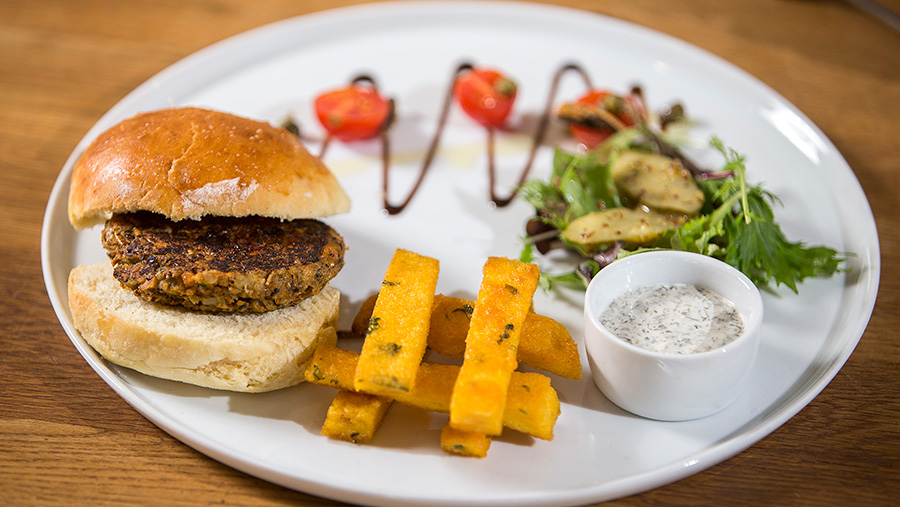
A bug burger
The Grub Kitchen menu
These insects would be used to produce the dishes Andy serves up at Grub Kitchen.
Edible insects have a certain novelty value but the number of repeat customers at restaurant is confirmation that they taste good, too.
Grub Kitchen’s gourmet bug burgers and onion and spinach bug bhajis are among the most popular dishes and Andy is forever experimenting with new recipes and flavours; infusing mealworms with coffee beans to give a nutty flavour to coffee, crusting goat’s cheese with black ants or baking cakes with the cricket flour.
“I like to create dishes that people can identify with,” he says.
“It’s all very well watching someone in a jungle reluctantly eating a squirming insect from the end of a stick, but in reality that is an extreme and, in my opinion, unethical representation of entomophagy [eating insects].
“Up until very recently the only view people have had of eating insects is through this negative media portrayal so you can understand why people would be hesitant to try them.
“But after just two minutes of positively educating people on the benefits of eating insects, nutritionally and environmentally, 99% of people will at least try them and most people are amazed by just how great they taste.”
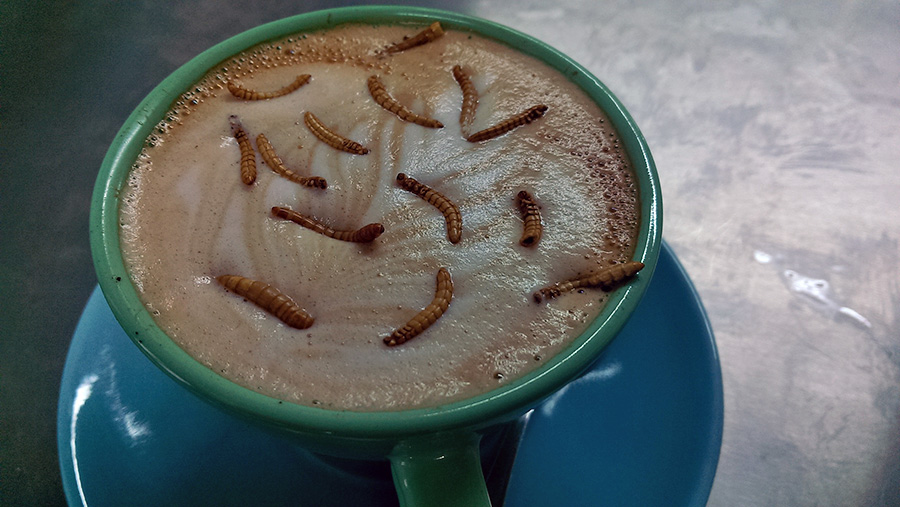
A mealworm macchiato
Edible insects are included at all stages of Grub Kitchen’s menu, from starters and snacks to desserts, so for those of us with a sweet tooth there are cricket and caramel panna cotta, bug pralines and cookies made from milled cricket flour.
Grinding the insect adds flavour and protein without the crispy reminder that you have just eaten an insect, yet still with a distinct and slightly savoury nutty taste
Andy explains that some of his dishes contain the same amount of protein, if not more, than the equivalent dish made with conventional protein with the added benefit that fewer resources are needed to produce that protein.
It’s not just insects on the menu at Grub Kitchen – there are many dishes showcasing the best of local and Welsh produce.
Sarah and her fellow Bug Farm staff are frequently the beneficiaries of Andy’s culinary experiments.
“Andy will quite often appear in the office with a tray of food he has been trialling,” she says.
Although Sarah is a gifted scientist and accomplished farmer, she admits to shortcomings in the kitchen.
“Andy does all the cooking and he is very good at it.
“You can always recognise an Andy dish, it has a wonderful depth of flavour and he presents it beautifully.
“It’s art on a plate.”
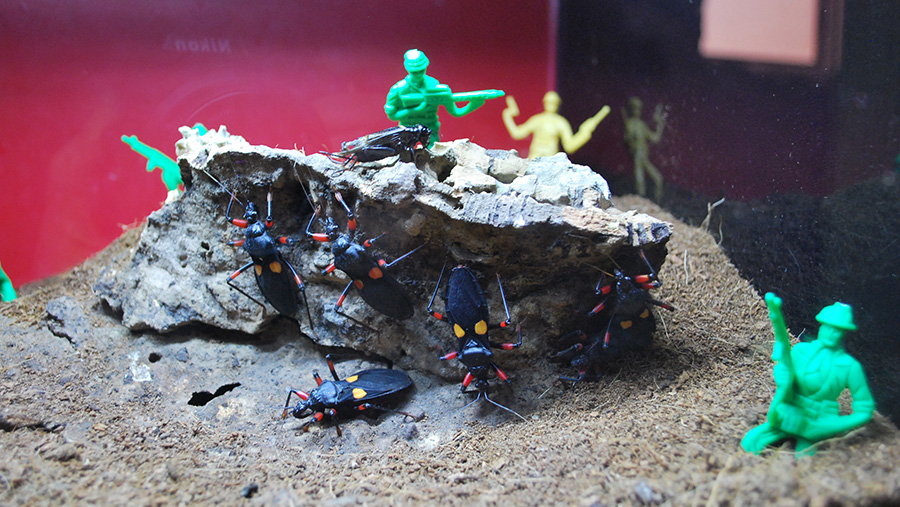
Assassin bugs
Edible insects
Crickets: Eaten toasted, roasted, or milled into a flour, the cricket is one of the most commonly eaten insects. Crickets taste like roasted nuts or dark chocolate and they also take on the flavour of their feed.
Mealworms: The larvae of the mealworm beetle taste like nutty puffed rice. Their overall nutritional value is comparable with beef.
Ants: A wide range of ant species are eaten across the world. Some taste like Marmite with a citrus tang, due to the formic acid they contain. Some people also think ants taste like a peaty whisky.
Grasshoppers: Grasshoppers and locusts are farmed for food in many countries. For example the chapuline or “red grasshopper” is part of the staple diet in the Oaxaca region of Mexico.
Buffalo worms: These beetle larvae have a distinctive nutty flavour similar to a mealworm, but a bit more subtle.
